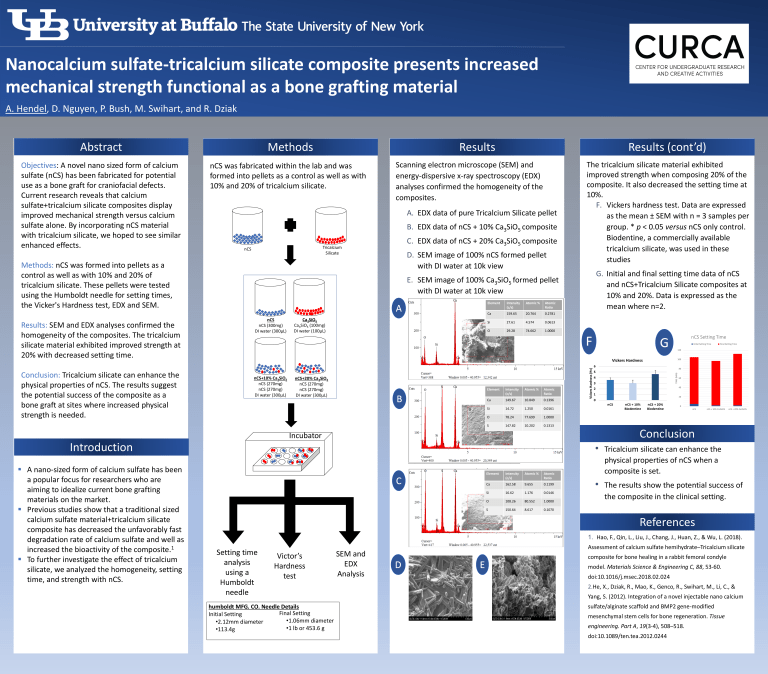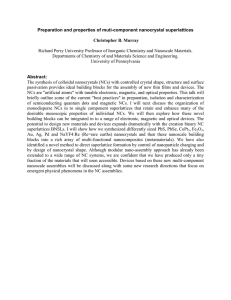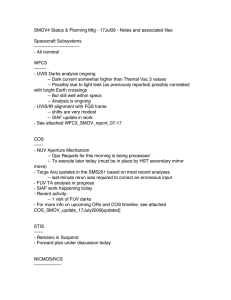Nanocalcium sulfate-tricalcium silicate composite presents increased mechanical strength functional as a bone grafting material
advertisement

Nanocalcium sulfate-tricalcium silicate composite presents increased mechanical strength functional as a bone grafting material A. Hendel, D. Nguyen, P. Bush, M. Swihart, and R. Dziak Abstract Methods Objectives: A novel nano sized form of calcium sulfate (nCS) has been fabricated for potential use as a bone graft for craniofacial defects. Current research reveals that calcium sulfate+tricalcium silicate composites display improved mechanical strength versus calcium sulfate alone. By incorporating nCS material with tricalcium silicate, we hoped to see similar enhanced effects. nCS was fabricated within the lab and was formed into pellets as a control as well as with 10% and 20% of tricalcium silicate. Results Results (cont’d) Scanning electron microscope (SEM) and energy-dispersive x-ray spectroscopy (EDX) analyses confirmed the homogeneity of the composites. A. EDX data of pure Tricalcium Silicate pellet B. EDX data of nCS + 10% Ca3SiO5 composite Tricalcium Silicate nCS Methods: nCS was formed into pellets as a control as well as with 10% and 20% of tricalcium silicate. These pellets were tested using the Humboldt needle for setting times, the Vicker's Hardness test, EDX and SEM. Results: SEM and EDX analyses confirmed the homogeneity of the composites. The tricalcium silicate material exhibited improved strength at 20% with decreased setting time. Results C. EDX data of nCS + 20% Ca3SiO5 composite D. SEM image of 100% nCS formed pellet with DI water at 10k view E. SEM image of 100% Ca3SiO5 formed pellet with DI water at 10k view nCS nCS (300mg) DI water (300µL) Ca3SiO5 Ca3SiO5 (100mg) DI water (100µL) Element Intensity (c/s) Atomic % Atomic Ratio Ca 159.65 20.764 0.2781 Si 27.61 4.574 0.0613 O 29.28 74.662 1.0000 The tricalcium silicate material exhibited improved strength when composing 20% of the composite. It also decreased the setting time at 10%. F. Vickers hardness test. Data are expressed as the mean ± SEM with n = 3 samples per group. * p < 0.05 versus nCS only control. Biodentine, a commercially available tricalcium silicate, was used in these studies G. Initial and final setting time data of nCS and nCS+Tricalcium Silicate composites at 10% and 20%. Data is expressed as the mean where n=2. nCS Setting Time Initial Setting Time Final Setting Time 120 100 Conclusion: Tricalcium silicate can enhance the physical properties of nCS. The results suggest the potential success of the composite as a bone graft at sites where increased physical strength is needed. nCS+10% Ca3SiO5 nCS (270mg) nCS (270mg) DI water (300µL) TIME (MIN) 80 nCS+20% Ca3SiO5 nCS (270mg) nCS (270mg) DI water (300µL) Element Intensity (c/s) Atomic % Atomic Ratio Ca 149.67 10.849 0.1396 Si 14.72 1.250 0.0161 O 78.24 77.699 1.0000 S 147.82 10.202 0.1313 40 20 0 nCS nCS + 10% Ca3SiO5 nCS + 20% Ca3SiO5 ConclusionConclusion Incubator Introduction ▪ A nano-sized form of calcium sulfate has been a popular focus for researchers who are aiming to idealize current bone grafting materials on the market. ▪ Previous studies show that a traditional sized calcium sulfate material+tricalcium silicate composite has decreased the unfavorably fast degradation rate of calcium sulfate and well as increased the bioactivity of the composite.1 ▪ To further investigate the effect of tricalcium silicate, we analyzed the homogeneity, setting time, and strength with nCS. 60 • Tricalcium silicate can enhance the Element Intensity (c/s) Atomic % Atomic Ratio Ca 162.58 9.655 0.1199 Si 16.62 1.176 0.0146 O 108.26 80.552 1.0000 S 150.64 8.617 0.1070 physical properties of nCS when a composite is set. • The results show the potential success of the composite in the clinical setting. ReferencesReferences 1. Hao, F., Qin, L., Liu, J., Chang, J., Huan, Z., & Wu, L. (2018). Setting time analysis using a Humboldt needle Victor’s Hardness test humboldt MFG. CO. Needle Details Final Setting Initial Setting •1.06mm diameter •2.12mm diameter •1 lb or 453.6 g •113.4g SEM and EDX Analysis Assessment of calcium sulfate hemihydrate–Tricalcium silicate composite for bone healing in a rabbit femoral condyle model. Materials Science & Engineering C, 88, 53-60. doi:10.1016/j.msec.2018.02.024 2.He, X., Dziak, R., Mao, K., Genco, R., Swihart, M., Li, C., & Yang, S. (2012). Integration of a novel injectable nano calcium sulfate/alginate scaffold and BMP2 gene-modified mesenchymal stem cells for bone regeneration. Tissue engineering. Part A, 19(3-4), 508–518. doi:10.1089/ten.tea.2012.0244




